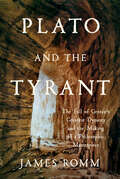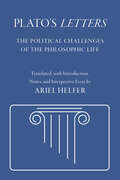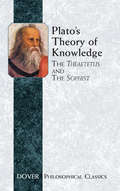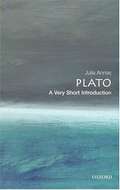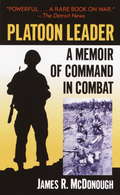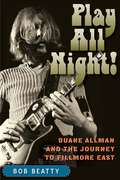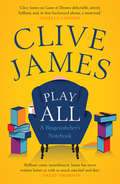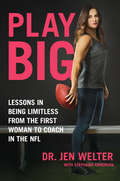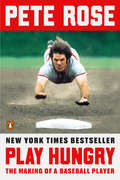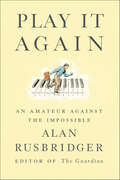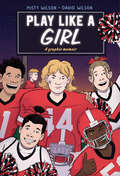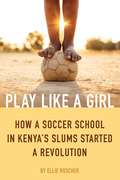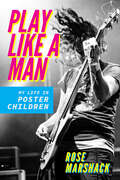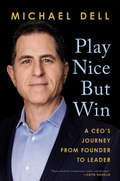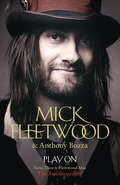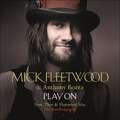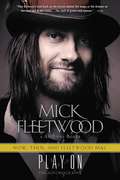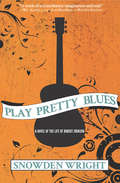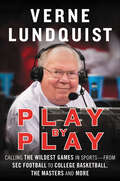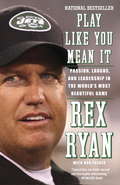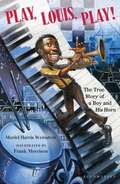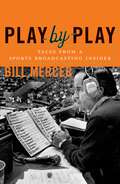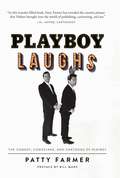- Table View
- List View
Plato and the Tyrant: The Fall of Greece's Greatest Dynasty and the Making of a Philosophic Masterpiece
by James RommFrom an eminent historian and classicist, an incisive portrait of the philosopher Plato, showing how the ideas in his masterwork, Republic, were tested by violent events in the most powerful Greek city of the era. Plato is one of history’s most influential thinkers, the “sublime philosopher” whose writings remain foundational to Western culture. He is known for the brilliant dialogues in which he depicted his teacher, Socrates, discussing ethical truths with prominent citizens of Athens. Yet the image we have of Plato—an ethereal figure far removed from society and politics, who conjured abstract ideas in peaceful groves—is a fiction, created by Plato’s admirers and built up over centuries. In fact, Plato was very much a man of the world. In Plato and the Tyrant, acclaimed historian and classicist James Romm draws on personal letters of Plato—documents that have long been kept in obscurity—to show how a philosopher helped topple the leading Greek power of the era: the opulent city of Syracuse. There, Plato encountered two authoritarian rulers, a father and son both named Dionysius, and tried to steer them toward philosophy. At the same time, he worked on his masterpiece, Republic, in which he conceived a ruler who unites perfect wisdom with absolute power. That dream has echoed down through the ages and given rise to a famous term, one that Plato himself didn’t actually use: philosopher-king. As Romm reveals, Plato’s time in Syracuse helped shape Republic—and also had disastrous results for Plato himself and for all of Greek Sicily. The younger Dionysius, emotionally unstable but intellectually curious, welcomed Plato with open arms, but soon the relationship soured. Plato’s close friendship with Dionysius’s uncle, Dion—possibly a bond of romantic love—created a rift in the ruling family that led to a chaotic civil war. Combining thrilling political drama with explorations of Plato’s most cherished ideas, Romm takes us into the heart of Greece’s late classical age, a time when many believed that democracy had failed. Plato’s search for solutions led him to write his fervent plea for a new political order, and also led him to a place where he believed his theories might be put into practice. But Plato and the Tyrant demonstrates how Plato’s experiment with enlightened autocracy spiraled into catastrophe, and also gives us nothing less than a new account of the origins of Western political thought.
Plato's "Letters": The Political Challenges of the Philosophic Life (Agora Editions)
by PlatoIn Plato's "Letters", Ariel Helfer provides to readers, for the first time, a highly literal translation of the Letters, complete with extensive notes on historical context and issues of manuscript transmission. His analysis presents a necessary perspective for readers who wish to study Plato's Letters as a work of Platonic philosophy. Centuries of debate over the provenance and significance of Plato's Letters have led to the common view that the Letters is a motley collection of jewels and scraps from within and without Plato's literary estate. In a series of original essays, Helfer describes how the Letters was written as a single work, composed with a unity of purpose and a coherent teaching, marked throughout by Plato's artfulness and insight and intended to occupy an important place in the Platonic corpus. Viewed in this light, the Letters is like an unusual epistolary novel, a manner of semifictional and semiautobiographical literary-philosophic experiment, in which Plato sought to provide his most demanding readers with guidance in thinking more deeply about the meaning of his own career as a philosopher, writer, and political advisor.Plato's "Letters" not only defends what Helfer calls the "literary unity thesis" by reviewing the scholarly history pertaining to the Platonic letters but also brings out the political philosophic lessons revealed in the Letters. As a result, Plato's "Letters" recovers and rehabilitates what has been until now a minority view concerning the Letters, according to which this misunderstood Platonic text will be of tremendous new importance for the study of Platonic political philosophy.
Plato's Theory of Knowledge: The Theaetetus and the Sophist (Dover Philosophical Classics Ser.)
by Plato Francis M. CornfordTranslated by the noted classical scholar Francis M. Cornford, this edition of two masterpieces of Plato's later period features extensive ongoing commentaries by Cornford that provide helpful background information and valuable insights. Both works pose eternal questions that keep these dialogs ever-relevant not only for students of philosophy but also for every reader and thinker. The Theatetus offers a systematic treatment of the question, "What is knowledge?" Most of the dialog takes place between Socrates and the student Theatetus. Among the answers they explore: knowledge as perception; knowledge as true belief; knowledge as true belief plus an account (i.e., a justified true belief); as well as variations on each of these answers. Like most Socratic dialogs, the Theatetus ends without a definitive answer — leaving the subject open for the reader's further consideration. In the Sophist, a related dialog, Plato redefines the term "sophist," which hitherto had connoted one who gives sophia (wisdom) to his disciples. Plato depreciated the term, and ever since, in philosophy, sophistry indicates the deceptive exploitation of linguistic ambiguities. The dialog follows Socrates' cross-examination of a self-proclaimed true philosopher, The Stranger, on the distinction between philosophers, statesmen, and sophists.
Plato: A Very Short Introduction
by Julia AnnasJulia Annas covers Plato's style of writing, and delves into discussions of love and philosophy, his attitude towards women and towards homosexual love. Finally, she explores Plato's claim that virtue is sufficient for happiness and touches on his arguments for the immorality of the soul and his ideas about the nature of the universe.
Platoon Leader
by James R. McdonoughA remarkable memoir of small-unit leadership and the coming of age of a young soldier in combat in Vietnam.'"Using a lean style and a sense of pacing drawn from the tautest of novels, McDonough has produced a gripping account of his first command, a U.S. platoon taking part in the 'strategic hamlet' program. . . . Rather than present a potpourri of combat yarns. . . McDonough has focused a seasoned storyteller's eye on the details, people, and incidents that best communicate a visceral feel of command under fire. . . . For the author's honesty and literary craftsmanship, Platoon Leader seems destined to be read for a long time by second lieutenants trying to prepare for the future, veterans trying to remember the past, and civilians trying to understand what the profession of arms is all about."-Army TimesFrom the Paperback edition.
Platoon Leader: A Memoir of Command in Combat
by James R. McdonoughA remarkable memoir of small-unit leadership and the coming of age of a young soldier in combat in Vietnam. ' "Using a lean style and a sense of pacing drawn from the tautest of novels, McDonough has produced a gripping account of his first command, a U. S. platoon taking part in the 'strategic hamlet' program. . . . Rather than present a potpourri of combat yarns. . . McDonough has focused a seasoned storyteller's eye on the details, people, and incidents that best communicate a visceral feel of command under fire. . . . For the author's honesty and literary craftsmanship,Platoon Leaderseems destined to be read for a long time by second lieutenants trying to prepare for the future, veterans trying to remember the past, and civilians trying to understand what the profession of arms is all about. "-Army Times From the Paperback edition.
Play All Night!: Duane Allman and the Journey to Fillmore East
by Bob BeattyThe origin story of a groundbreaking album The 1971 Allman Brothers Band album At Fillmore East was a musical manifesto years in the making. In Play All Night!, Bob Beatty dives deep into the motivations and musical background of band founder Duane Allman to tell the story of what made this album not just a smash hit, but one of the most important live rock albums in history. Featuring insights from bootleg tapes, radio ads, early reviews, never-before-published photos, and the memories of band members, fans, and friends, Beatty chronicles how Allman rejected the traditional route of music business success—hit singles and record sales—and built a band that was at its best jamming live on stage, feeding off the crowd’s energy, and pushing each other to new heights of virtuosic improvisation. Every challenge, from recruiting a group of relatively unknown but established musicians like Jaimoe and Dickey Betts, touring the American South as an interracial band, and the failure of their first two studio albums, sharpened Allman’s determination to pursue the band’s truly unique sound. He made a bold choice—to record their next album live at Bill Graham’s famous concert hall in New York’s Lower East Side, a gamble that launched a new strand of American music to the top of the charts. Four days after the album went gold, Duane Allman was killed in a motorcycle accident. He was 24. This book explores how At Fillmore East cemented Allman’s legacy as a strong-willed, self-taught visionary, giving fans of Southern rock and all readers interested in the role of rock music in American popular culture a new appreciation for this pathbreaking album.
Play All: A Bingewatcher's Notebook
by Clive James&“A loving and breezy set of essays&” on today&’s most addictive TV shows from &“an incisive and hilarious critic&” (Slate). Television is not what it once was. Award-winning author and critic Clive James spent decades covering the medium, and witnessed a radical change in content, format, and programming, and in the very manner in which TV is watched. Here he examines this unique cultural revolution, providing a brilliant, eminently entertaining analysis of many of television&’s most notable twenty-first-century accomplishments and their not always subtle impact on modern society—including such acclaimed serial dramas as Breaking Bad, The West Wing, Mad Men, and The Sopranos and the comedy 30 Rock. With intelligence and wit, James explores a television landscape expanded by cable and broadband and profoundly altered by the advent of Netflix, Amazon, and other cord-cutting platforms that have helped to usher in a golden age of unabashed binge-watching. &“James loves television, he loves the winding stories it tells and that we share them together. Play All is a late love letter to the medium of our lives.&”—Sunday Times &“Large-brained and largehearted, and written with astonishing energy.&”—The New York Times Book Review &“Witty and insightful musing on popular and critically acclaimed series of the past two decades.&”—Publishers Weekly
Play Big: Lessons in Being Limitless from the First Woman to Coach in the NFL
by Jen Welter Stephanie KrikorianWhen Jen Welter became a linebackers coach for the Arizona Cardinals in 2015, she was the first woman to ever break the glass sideline of the NFL. In Play Big, Welter reveals the grit that it took to be a trailblazer in the ultimate boys' club. Pre-NFL, Welter was an undersized, underestimated athlete who made sacrifice after sacrifice to acheive her football dreams--rising to the top of women's football leagues and eventually daring to play against men twice her size. Play Big lays out how she succeeded despite the odds, through force of will and determination, revealing the wisdom Welter gained over countless setbacks and challenges. With vivid wit and candor, Play Big will coach you to do the same--whatever your obstacles might be--while translating Welter's hard-earned advice for cultivating true perseverance and toughness.
Play Hungry: The Making of a Baseball Player
by Pete RoseThe inside story of how Pete Rose became one of the greatest and most controversial players in the history of baseball Pete Rose was a legend on the field. As baseball’s Hit King, he shattered records that were thought to be unbreakable. And during the 1970s, he was the leader of the Big Red Machine, the Cincinnati Reds team that dominated the game. But he’s also the greatest player who may never enter the Hall of Fame because of his lifetime ban from the sport. Perhaps no other ballplayer’s story is so representative of the triumphs and tragedies of our national pastime. In Play Hungry, Rose tells us the story of how, through hard work and sheer will, he became one of the unlikeliest stars of the game. Guided by the dad he idolized, a local sports hero, Pete learned to play hard and always focus on winning. But even with his dad’s guidance, Pete was cut from his team as a teenager—he wasn’t a natural. Rose was determined, though, and never would be satisfied with anything less than success. His relentless hustle and headfirst style would help him overcome his limitations, leading him to one of the most exciting and brash careers in the history of the sport. Play Hungry is Pete Rose’s love letter to the game, and an unvarnished story of life on the diamond. One of the icons of a golden age in baseball, he describes just what it was like to hit (or try to hit) a Bob Gibson fastball or a Gaylord Perry spitball, what happened in that infamous collision at home plate during the 1970 All-Star Game, and what it felt like to topple Ty Cobb’s hit record. And he speaks to how he let down his fans, his teammates, and the memory of his dad when he gambled on baseball, breaking the rules of a sport that he loved more than anything else. Told with candor and wry humor—including tales he’s never told before—Rose’s memoir is his final word on the glories and controversies of his life, and, ultimately, a master class in how to succeed when the odds are stacked against you.
Play It Again: An Amateur Against the Impossible
by Alan RusbridgerThe Guardian editor and amateur pianist’s account of a remarkable musical challenge during an extraordinary year for news.As editor of the Guardian, one of the world’s foremost newspapers, Alan Rusbridger lives by the relentless twenty-four-hour news cycle. But increasingly in midlife, he feels the gravitational pull of music—especially the piano. He sets himself a formidable challenge: within a year, to fluently learn Chopin’s magnificent Ballade No. 1 in G minor, arguably one of the most difficult Romantic compositions in the repertory. With pyrotechnic passages that require feats of memory, dexterity, and power, the piece is one that causes alarm even in battle-hardened concert pianists.Under ideal circumstances, this would have been a daunting task. But the particular year Rusbridger chooses turns out to be one of frenetic intensity, beginning with WikiLeaks’ massive dump of state secrets and ending with the Guardian’s revelations about widespread phone hacking at News of the World. “In between, there were the Japanese tsunami, the Arab Spring, the English riots . . . and the death of Osama Bin Laden,” writes Rusbridger. The test would be to “nibble out” twenty minutes per day to do something totally unrelated to these events.Rusbridger’s subject is larger than any one piece of music: Play It Again deals with focus, discipline, and desire but is, above all, about the sanctity of one’s inner life in a world dominated by deadlines and distractions.Praise for Play It Again“An absorbing, adroitly crafted tale of humility, discipline and the sheer love of music . . . [Alan Rusbridger’s] triumph is an inspiration.” —Katie Hafner, The New York Times Book Review“A unique mélange of political and musical reportage . . . [Alan Rusbridger] illuminates not only print media in this digital age but also the changing role of the music within.” —Iain Burnside, The Observer (London)
Play Like a Girl
by Misty WilsonDebut author Misty Wilson chronicles her seventh-grade experience as the only girl on her town’s football team in this empowering graphic memoir about teamwork, friendship, crushes, and touchdowns.Misty never shies away from a challenge, on or off the field. So when the boys tell her she can’t play football, there’s only one thing to do: join their team and show them what she’s got.But the training is rougher than she thought—and so are the other guys, who aren’t thrilled about having a girl on their team.Middle school isn’t so easy, either. Misty wants to fit in with the popular kids, but they think a girl playing football is “weird.” Even her best friend doesn’t get it.Can Misty find a way to score points with her teammates, make new friends, and show everyone—including herself—what it means to play like a girl?“I am a huge fan of Misty and her courageous journey of staying true to herself. Readers will love her!” —Terri Libenson, New York Times bestselling author of the Emmie & Friends series“This is the book I wish I’d had as a kid. Misty’s passion for football and her fight to play in a male-dominated sport while balancing friendship and crushes makes for a winning read!” —Dr. Jen Welter, first female NFL coach, first female running back in men’s pro football, and founder of Grrridiron Girls
Play Like a Girl: How a Soccer School in Kenya's Slums Started a Revolution
by Ellie RoscherGrowing up and living in Kibera, Kenya, Abdul Kassim was well aware of the disproportionate number of challenges faced by women due to the extreme gender inequalities that persist in the slums. After being raised by his aunts, mother, and grandmother and having a daughter himself, he felt that he needed to make a difference. In 2002, Abdul started a soccer team for girls called Girls Soccer in Kibera (GSK), with the hope of fostering a supportive community and providing emotional and mental support for the young women in the town. The soccer program was a success, but the looming dangers of slum life persisted, and the young women continued to fall victim to the worst kinds of human atrocities. Indeed, it was the unyielding injustice of these conditions that led Abdul to the conclusion that soccer alone was not enough to create the necessary systemic change. In 2006, after much work, the Kibera Girls Soccer Academy (KGSA) was established with their first class of 11 girls and 2 volunteer teachers. Today, KGSA is composed of 20 full-time staff, provides a host of artistic and athletic programs for more than 130 students annually, and continues to expand. By providing academics inside and outside of the classroom along with artistic and athletic opportunities, KGSA inspires the young women of Kibera to become advocates for change within their own communities and for Kenya as a whole. Play Like a Girl tells the KGSA story through Abdul’s voice and vision and the stories of key staff and students. It is written by Ellie Roscher who spent 2 summers doing research at KGSA and several years writing this book.
Play Like a Man: My Life in Poster Children (Music in American Life)
by Rose MarshackAs a member of Poster Children, Rose Marshack took part in entwined revolutions. Marshack and other women seized a much-elevated profile in music during the indie rock breakthrough while the advent of new digital technologies transformed the recording and marketing of music. Touring in a van, meeting your idols, juggling a programming job with music, keeping control and credibility, the perils of an independent record label (and the greater perils of a major)—Marshack chronicles the band’s day-to-day life and punctuates her account with excerpts from her tour reports and hard-learned lessons on how to rock, program, and teach while female. She also details the ways Poster Children applied punk’s DIY ethos to digital tech as a way to connect with fans via then-new media like pkids listservs, internet radio, and enhanced CDs. An inside look at a scene and a career, Play Like a Man is the evocative and humorous tale of one woman’s life in the trenches and online.
Play Nice But Win: A CEO's Journey from Founder to Leader
by James Kaplan Michael DellFrom Michael Dell, renowned founder and chief executive of one of America&’s largest technology companies, the inside story of the battles that defined him as a leaderIn 1984, soon-to-be college dropout Michael Dell hid signs of his fledgling PC business in the bathroom of his University of Texas dorm room. Almost 30 years later, at the pinnacle of his success as founder and leader of Dell Technologies, he found himself embroiled in a battle for his company&’s survival. What he&’d do next could ensure its legacy—or destroy it completely. Play Nice But Win is a riveting account of the three battles waged for Dell Technologies: one to launch it, one to keep it, and one to transform it. For the first time, Dell reveals the highs and lows of the company's evolution amidst a rapidly changing industry—and his own, as he matured into the CEO it needed. With humor and humility, he recalls the mentors who showed him how to turn his passion into a business; the competitors who became friends, foes, or both; and the sharks that circled, looking for weakness. What emerges is the long-term vision underpinning his success: that technology is ultimately about people and their potential. More than an honest portrait of a leader at a crossroads, Play Nice But Win is a survival story proving that while anyone with technological insight and entrepreneurial zeal might build something great—it takes a leader to build something that lasts.
Play On: Now, Then and Fleetwood Mac
by Mick Fleetwood"After forty-six years of being on the road, now is the right time to look back in a way I've never done before: now and then. I'm looking forward to sharing it with you." Mick Fleetwood has been part of one of the world's most successful and adored bands for over four decades. Here he tells the full and candid story of that life, and what it is to be part of the ever evolving Fleetwood Mac. His all-access autobiography spans the career of one of classic rock's greatest drummers and band leaders, the co-founder of the deeply loved super group that bears his name. In this intimate portrait of a life lived in music, Fleetwood vividly recalls his upbringing in Cornwall, Egypt and Norway tapping along to whatever song was playing on the radio; his experiences as a musician in Sixties London; the early days of the band featuring Peter Green, and his close friendship with George Harrison and seemingly all of music royalty. Play On sheds new light on Fleetwood Mac's raucous history describing the highs and lows of being part of a band that he often single-handedly kept together. His love affair with Stevie Nicks, the creation of landmark albums like Rumours and Tusk, and the many incredible and outrageous moments of recording, touring, fighting, and loving with Fleetwood Mac: all are here. He describes his life's moments with the honesty and immediacy that his fans expect, taking us to the very heart of this multi layered life. It's been a tumultuous journey with the excesses of the band's huge success at times threatening to destroy what they strived so hard to create. But through it all it's been the drive to play on that has won out. Now, then, and always, it's Fleetwood Mac.
Play On: Now, Then and Fleetwood Mac
by Mick Fleetwood"After forty-six years of being on the road, now is the right time to look back in a way I've never done before: now and then. I'm looking forward to sharing it with you." Mick Fleetwood has been part of one of the world's most successful and adored bands for over four decades. Here he tells the full and candid story of that life, and what it is to be part of the ever evolving Fleetwood Mac. His all-access autobiography spans the career of one of classic rock's greatest drummers and band leaders, the co-founder of the deeply loved super group that bears his name. In this intimate portrait of a life lived in music, Fleetwood vividly recalls his upbringing in Cornwall, Egypt and Norway tapping along to whatever song was playing on the radio; his experiences as a musician in Sixties London; the early days of the band featuring Peter Green, and his close friendship with George Harrison and seemingly all of music royalty. Play On sheds new light on Fleetwood Mac's raucous history describing the highs and lows of being part of a band that he often single-handedly kept together. His love affair with Stevie Nicks, the creation of landmark albums like Rumours and Tusk, and the many incredible and outrageous moments of recording, touring, fighting, and loving with Fleetwood Mac: all are here. He describes his life's moments with the honesty and immediacy that his fans expect, taking us to the very heart of this multi layered life. It's been a tumultuous journey with the excesses of the band's huge success at times threatening to destroy what they strived so hard to create. But through it all it's been the drive to play on that has won out. Now, then, and always, it's Fleetwood Mac.(P)2014 Hodder & Stoughton
Play On: Now, Then, and Fleetwood Mac: The Autobiography
by Mick Fleetwood Anthony BozzaMick Fleetwood, the drummer and cofounder of the mega-selling band Fleetwood Mac, tells all.In this candid, intimate portrait of a life lived in music, Mick Fleetwood sheds new light on well-known points in his history, including many incredible moments of recording and touring with Fleetwood Mac, as well as personal insights from a man who has been a major player in blues and rock n' roll since his teens.The group Fleetwood Mac has sold over 140 million records worldwide, and they continue to attract a huge following, selling out their biggest arena tour ever in 2013, decades after their debut. Finally, the group's admirers will have a unique portrait of what made Mick and the rest of the group tick in the midst of their massive success and personal trials.
Play Pretty Blues
by Snowden WrightThe mysteries of blues legend Robert Johnson's live and death long ago became myth. Part researched reconstruction, part vivid imagination, this lyrical novel brings Johnson alive through the voices of his six wives, revealing the husband and son inside the legend, illuminating the vacuum Johnson left in the worlds of those who loved him and those he would never meet.
Play by Play: Calling the Wildest Games in Sports–From SEC Football to College Basketball, The Masters, and More
by Verne LundquistThe SEC. The Masters. The Olympics. March Madness. The Dallas Cowboys. Yes sir, Uncle Verne has seen it all.Over the last fifty years, few voices have epitomized the sound of sports television quite like that of Verne Lundquist’s. A fixture on air since the 1960s—first broadcasting University of Texas baseball and Dallas Cowboys football games on radio before eventually joining the legendary CBS Sports team—Verne has covered just about every sport there is, and in the process he’s made some of the most enduring calls in the history of golf, football, figure skating—and everything in between.In Play by Play, Verne goes inside those calls and his remarkable career, telling the behind-the-scenes story of how he ended up with the best seats in the house, giving voice to history time and time again. From Christian Laettner’s buzzer-beater in the 1992 NCAA tournament, to the saga of Nancy Kerrigan and Tonya Harding at the 1994 Olympics, to the shocking finish of the Iron Bowl in 2013, to Jack Nicklaus’s and Tiger Woods’s unforgettable victories at the Masters, Verne’s five decades as a sportscaster routinely put him in the midst of greatness. With his trademark humility and his goal to make the athlete the legend, instead of the call itself, Verne details his view of the plays that have captured our collective imagination for two generations, featuring an incredible cast of characters that includes names like Terry Bradshaw, Pat Summerall, John Madden, Scott Hamilton, and Tom Landry.What emerges is an invigorating portrait of the games that matter most, in life and on the field. A moving recollection of the moments that make sports worth watching, Play by Play reminds us all that sports are about more than games played—they’re about the history that we share together and the voices that we remember long after the final whistle has blown.
Play like You Mean It: Passion, Laughs, and Leadership in the World's Most Beautiful Game
by Rex RyanNo football fan will want to be without the book that delivers pure, unfiltered Rex Ryan--head coach of the New York Jets and one of the most popular, outspoken, well-liked, and widely respected personalities in the National Football League. Rex Ryan is known for his exuberance . . . and Play Like You Mean It explores every aspect of Ryan's amazing passion for the game of football, plus the lessons he has learned in leadership and motivation during his years in and around the game. In his own words, Ryan takes readers behind the scenes of the NFL as he shares colorful football stories from his experiences with the Jets and the Ravens as well as his years recruiting players, coaching college football, and growing up as a child of legendary NFL coach Buddy Ryan. Rex's unique brand of enthusiasm and motivation comes through on every page. Most of all, fans will get insider access to Ryan's headline-grabbing, brutally honest, and undeniably entertaining views on the NFL . . . and the very human side of the larger-than-life athletes who devote their lives to the game of football. From Ryan's acceptance of the Jets head coaching job to his success in turning around a team that has long been number two in New York, from his drafting and believing in Mark Sanchez to kicking off the 2010 season with massive expectations (and a target on his back)--this book goes deep, and entertains on every level.
Play, Louis, Play!: The True Story of a Boy and his Horn
by Muriel Harris WeinsteinThe book delivers a rollicking biography of jazz great Louis Armstrong's childhood, told from the perspective of his dearest companion--his horn.
Play-by-Play: Tales from a Sportscasting Insider
by Bill MercerBoth a memoir and a "how-to" for anyone who aspires to a career in broadcast journalism, particularly sports, this book calls on Mercer's vast experience and name recognition in Texas to give an insider's view of everything from play-by-play to interviewing a celebrity athlete. Mercer began his career as the voice of professional wrestling in Dallas in the 1950s, and later went on to be a play-by-play announcer for teams ranging from the Dallas Cowboys to the Chicago White Sox, in addition to a brief "hard news" stint at the time of the Kennedy assassination in Dallas in 1963.
Playa Fire: Spirit and Soul at Burning Man
by Stewart HarveyForeword by Burning Man founder Larry HarveyA stunning visual and narrative homage—featuring more than 100 black & white and color photographs, many never before seen—that captures the wonder and metaphysical power of Burning Man past present, and future, and the magic that draws us to it, by the ultimate Burning Man insider.Growing up in 1950s Oregon, brothers Stewart and Larry Harvey rebelled against their small-town culture and the conformist norms of Eisenhower’s America. Stewart turned to photography. Larry, drawn by the siren call of the burgeoning counter-cultural movement, fled to San Francisco, where he met a group of alternative artists like himself. During his frequent visits south, Stewart, camera always in hand, photographed the intimate creative worlds of Larry and his friends—images that would chronicle the birth of one of the most important cultural, artistic, and social movements of the twentieth century: Burning Man.Filled with the rare insights of Stewart’s decades-long friendships with his brother and the five other founders, as well as the many people who have shaped it, Playa Fire is a Burning Man story like no other. An artist and writer of striking emotional depth, Stewart marries stunning photos reflecting the beauty and grandeur of the desert landscape and the ephemeral, hallucinatory beauty of Black Rock City with a compelling narrative journey that captures the landmark festival’s spiritual essence.Drawn from his personal archives and taken over thirty years at Burning Man—many at "First Camp"—his panoramic photographs are accompanied by never-before-seen memorabilia, including Larry’s original sketch of the first Man as well as family photos of the young Harvey brothers and their band of merrymakers. An exquisite work of art that embodies the radical imagination at the core of this transformative event, Playa Fire celebrates both the spectacle and the meditative that is Burning Man. It is an enchanting portrait for die-hard "Burners," arts enthusiasts, and the intellectually curious fascinated by this iconoclastic, beloved cultural phenomenon.
Playboy Laughs: The Comedy, Comedians, And Cartoons Of Playboy
by Patty FarmerFollowing her success with Playboy Swings, Patty Farmer looks at Playboy’s relationship with comedians and cartoonists in her new book Playboy Laughs. Playboy Laughs invites readers onto the sets of the organization’s groundbreaking TV shows, Playboy Penthouse and Playboy After Dark. These popular variety series brought top-tier comedians, impressionists, and monologists—as well as the finest musicians—into people’s homes each week. Readers will learn how before he ever dreamed of conquering the magazine publishing world—and along the way establish a worldwide brand—Hugh Hefner harbored aspirations of making his mark in the world as a cartoonist. Playboy Laughs delves into the darker aspects of the time as well, tackling the ways Playboy and its comedy stars helped break down social and racial barriers as well as sexual ones. Known for her devotion to meticulous research and clear, honest storytelling, Farmer has gained the full cooperation of the Playboy organization—and Hugh Hefner himself—making this not only an entertaining read but a trustworthy history of an under-appreciated aspect of American comic culture.
